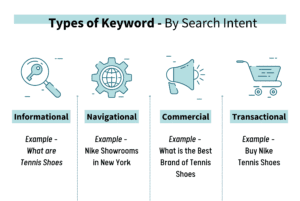Keywords 101: What Are They?

Keywords are the magic words or phrases that people type into search engines when they’re looking for information. Think of them as the bridge between what people are searching for and the content you provide. To optimize your website for search engines, you need to understand different types of keywords and how to use them effectively. Let’s dive in!
The Basic Keyword Types

1. Short-Tail Keywords
- What Are They? Short-tail keywords, also known as head keywords, are typically one to two words long. They are broad and have high search volume.
- Example: “Shoes”
- Usage: These are great for general topics but can be very competitive. Use them when you’re trying to cast a wide net.
- Expert Tip: Since short-tail keywords are highly competitive, they are better suited for larger brands with high authority websites.
2. Long-Tail Keywords
- What Are They? Long-tail keywords are more specific and usually longer, often containing three or more words.
- Example: “Best running shoes for women”
- Usage: Perfect for targeting niche audiences and driving more qualified traffic.
- Expert Tip: These keywords are less competitive and have higher conversion rates because they cater to specific searches.
Diving Deeper: More Types of Keywords

3. LSI (Latent Semantic Indexing) Keywords
- What Are They? LSI keywords are related to your main keyword. They help search engines understand the context of your content.
- Example: For the keyword “apple,” LSI keywords could be “fruit,” “MacBook,” “iPhone.”
- Usage: Use LSI keywords to make your content more comprehensive and contextually relevant.
- Expert Tip: Integrate LSI keywords naturally within your content to enhance its relevance and SEO performance.
4. Seed Keywords
- What Are They? Seed keywords are the foundation of your keyword research. They are broad terms that you build your keyword strategy around.
- Example: “Fitness”
- Usage: Use seed keywords to generate a list of related long-tail keywords and LSI keywords.
- Expert Tip: Start with seed keywords to brainstorm and then expand into more specific keywords.
Scenario-Based Keyword Usage

Scenario 1: Launching a New Product
- Keyword Type: Long-Tail Keywords
- Example: “Affordable smartwatches for kids”
- Why? When launching a new product, targeting long-tail keywords can attract a specific audience who are more likely to convert.
Scenario 2: Writing a Blog Post
- Keyword Type: LSI Keywords
- Example: For a blog post about “digital marketing trends,” LSI keywords could include “SEO,” “content marketing,” “social media.”
- Why? Using LSI keywords helps in creating content that is rich and contextually relevant, improving SEO.
Scenario 3: Building Brand Awareness
- Keyword Type: Short-Tail Keywords
- Example: “Healthy snacks”
- Why? To reach a broader audience and create brand awareness, short-tail keywords are effective despite their competitiveness.
Advanced Keywords for the Pros
5. Geo-Targeted Keywords
- What Are They? These keywords include specific locations to target local audiences.
- Example: “Best pizza in New York”
- Usage: Essential for local businesses or services.
- Expert Tip: Use geo-targeted keywords in your Google My Business profile to improve local SEO.
6. Buyer Intent Keywords
- What Are They? These keywords indicate that the searcher is ready to make a purchase.
- Example: “Buy noise-canceling headphones”
- Usage: Perfect for e-commerce websites aiming to convert visitors into customers.
- Expert Tip: Incorporate buyer intent keywords in your product pages and ad campaigns to drive sales.
7. Seasonal Keywords
- What Are They? These keywords are relevant during specific times of the year.
- Example: “Christmas gift ideas”
- Usage: Great for seasonal promotions and campaigns.
- Expert Tip: Plan your content calendar around seasonal keywords to capitalize on peak search times.
Creating a Winning Keyword Strategy
- Start with Seed Keywords: Begin your keyword research with broad terms.
- Expand to Long-Tail and LSI Keywords: Use tools like Google Keyword Planner, Ahrefs, and SEMrush to find related keywords.
- Analyze Competitors: Look at the keywords your competitors are ranking for and identify opportunities.
- Use Keywords Naturally: Incorporate keywords into your content in a way that feels natural and readable.
- Monitor and Adjust: Regularly track your keyword performance and adjust your strategy as needed.
Conclusion
Understanding and effectively using different types of keywords is crucial for SEO success. Whether you’re targeting broad terms with short-tail keywords or focusing on niche markets with long-tail keywords, each type plays a vital role in driving traffic and conversions. Start implementing these strategies today and watch your SEO efforts pay off!
Now, you’re equipped with the knowledge to conquer the keyword world. Ready to boost your SEO game? Let’s go!

